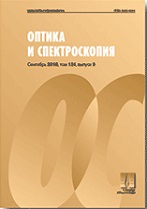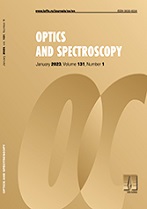|
This article is cited in 9 scientific papers (total in 9 papers)
Spectroscopy of condensed matter
Synthesis and luminescent properties of gadolinium tantalum niobates Gd(Nb$_{0.9}$Ta$_{0.1})$O$_{4}$
E. V. Ivanovaa, S. M. Masloboevab, V. A. Kraveza, K. N. Orekhovaa, G. A. Guseva, A. N. Trofimova, O. B. Shcherbinab, M. A. Yagovkinaa, A. A. Averinc, M. V. Zamoryanskayaa
a Ioffe Institute, St. Petersburg, Russia
b Tananaev Institute of Chemistry – Subdivision of the Federal Research Centre "Kola Science Centre of the Russian Academy of Sciences" Science Centre of Russian Academy of Sciences,
Apatity, Murmansk region, Russia
c Frumkin Institute of Physical chemistry and Electrochemistry Russian academy of sciences, Moscow, Russia
Abstract:
The feasibility of synthesizing gadolinium tantalum niobates by the liquid-phase method was demonstrated. The methods of X-ray diffraction, electron probe microanalysis, local cathodoluminescence, and photoluminescence were applied to study the samples. It was shown that under the selected synthesis conditions ($T\sim$ 1400$^\circ$C for 3 hours), no solid solution of niobium-tantalum was formed in the powder samples. When obtaining ceramic samples, it was possible to obtain a solid solution and to study the dependence of the luminescence intensity on the niobium content upon excitation of the samples by an electron beam. The maximum luminescence intensity was observed in the sample with the composition of GdNb$_{0.9}$Ta$_{0.1}$O$_{4}$. It was shown that the inhomogeneity of luminescence is not related to fluctuations in composition, but is related to the inhomogeneous distribution of vacancy centers, which are luminescence centers.
Keywords:
gadolinium tantalum niobates, cathodoluminescence, X-ray diffraction, electron probe microanalysis, liquid-phase synthesis.
Received: 01.10.2019
Revised: 01.10.2019
Accepted: 05.11.2019
Citation:
E. V. Ivanova, S. M. Masloboeva, V. A. Kravez, K. N. Orekhova, G. A. Gusev, A. N. Trofimov, O. B. Shcherbina, M. A. Yagovkina, A. A. Averin, M. V. Zamoryanskaya, “Synthesis and luminescent properties of gadolinium tantalum niobates Gd(Nb$_{0.9}$Ta$_{0.1})$O$_{4}$”, Optics and Spectroscopy, 128:2 (2020), 228; Optics and Spectroscopy, 127:6 (2019), 1011–1017
Linking options:
https://www.mathnet.ru/eng/os471 https://www.mathnet.ru/eng/os/v128/i2/p228
|


| Statistics & downloads: |
| Abstract page: | 25 | | Full-text PDF : | 12 |
|





 Contact us:
Contact us: Terms of Use
Terms of Use
 Registration to the website
Registration to the website Logotypes
Logotypes








 Citation in format
Citation in format 
